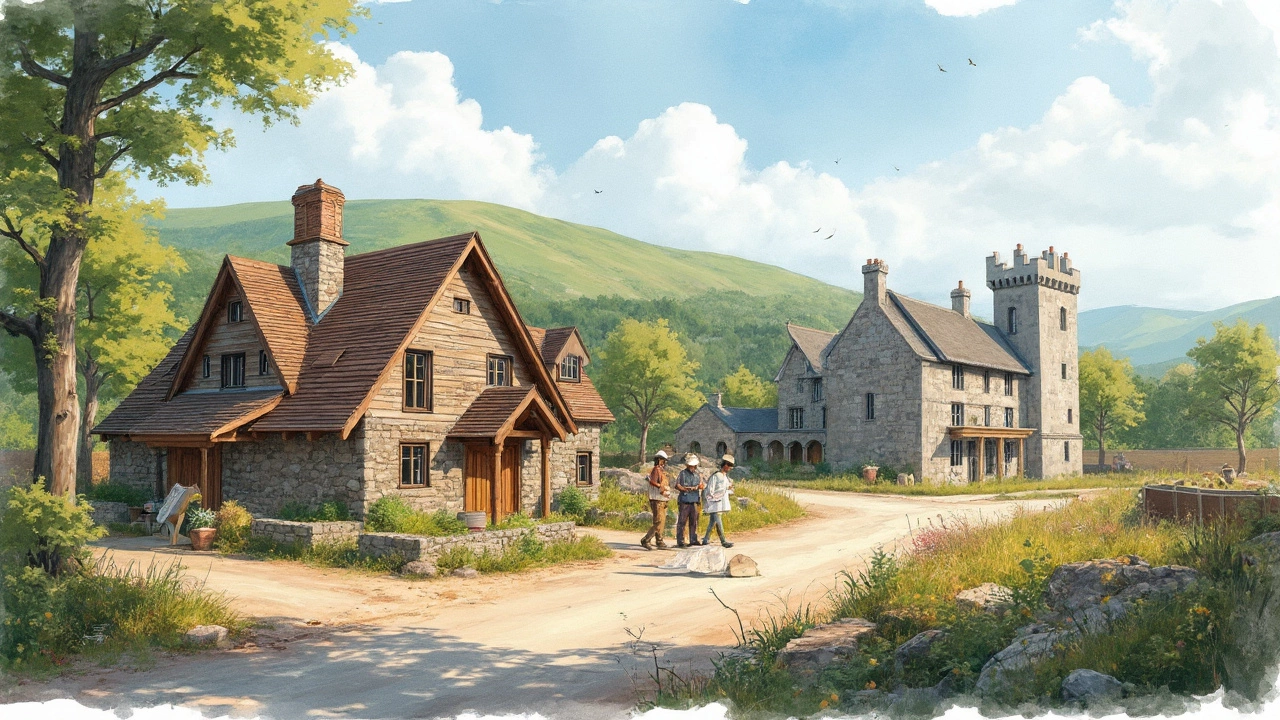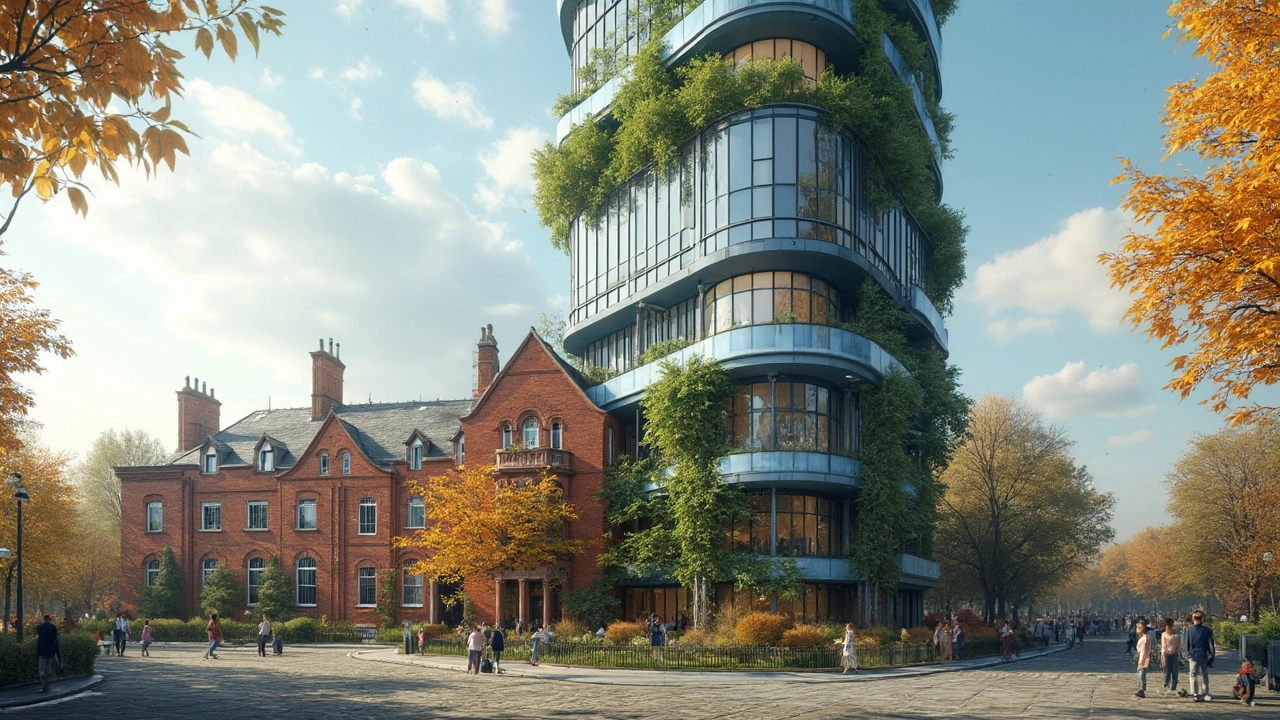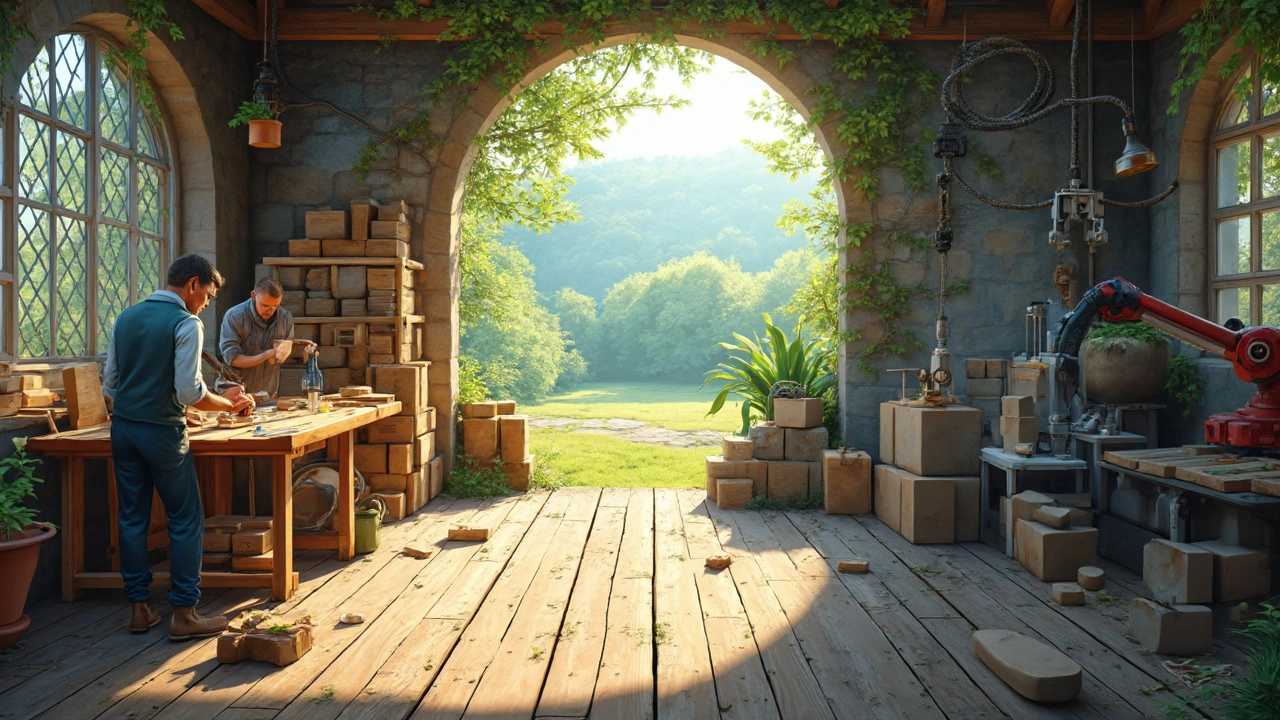What Are Most New Builds Made Of?
 Mar, 26 2025
Mar, 26 2025
So you're thinking about what goes into building a brand-new house. Ever wondered what's behind those sleek walls and stylish facades? Spoiler alert: it's not just bricks and mortar! Today's new builds are a mix of traditional and cutting-edge materials.
First off, there's the good old favorite: wood. It's still popular because it's versatile and looks great, but it's not the only player in the game anymore. Concrete's also on the scene, praised for its strength and durability. But here's the twist: more eco-friendly options like bamboo and recycled steel are making waves, too.
Why does this matter? Well, the materials you choose can affect everything from your home's energy efficiency to how much you pay upfront. Knowing a bit about these options can save you both headaches and money down the road.
Interested in being a part of the sustainable revolution? There are tons of exciting alternatives that not only help the environment but also boost your home's value. We'll cover these and more in our deep dive into what most new builds are made of.
- Traditional Materials with a Modern Twist
- Sustainable Alternatives Gaining Ground
- Innovative Techniques Shaping the Future
- Balancing Cost and Quality in Modern Homes
- Practical Tips for Your New Build Project
Traditional Materials with a Modern Twist
When it comes to new builds, some materials have stood the test of time but have gotten a bit of a makeover. Let's talk about these classic materials and see how they're being used in innovative ways today.
The Ever-Present Wood
Wood is like the little black dress of construction—always in style. It's loved for its natural beauty and versatility. But today, it's not just about plain wood. Engineered wood products, such as laminated veneer lumber (LVL), offer the same aesthetic with extra bang for your buck in terms of strength and stability.
These materials help reduce waste and make better use of forest resources. Plus, they're often treated for better resistance to moisture and pests, making them an even smarter choice for modern construction.
Concrete: More Than Just a Gray Block
Concrete is tough and durable, but who says it has to be boring? Modern techniques have breathed new life into this staple of construction materials. Colored concrete and stamped designs allow for customization that wasn't possible before. And let's not forget precast panels, which can speed up building times and cut costs.
Bricks: Not Just for Stately Homes
Bricks are another classic, but they're getting a modern update. Think different colors, textures, and eco-friendlier options. Porous bricks are now a thing, allowing water to pass through, which can be great for areas prone to flooding.
Using bricks made from reclaimed materials is also on the rise, giving old bricks a new lease on life and cutting down on production waste.
Steel: Strong and Reimagined
Steel's reputation for strength is unparalleled, but it's not just about building skyscrapers anymore. Steel frames are finding a place in residential modern homes. The key advantages? They're resistant to termites and fire, and they can support wide-open spaces without the need for interior walls.
| Material | Advantages |
|---|---|
| Wood | Versatile, aesthetic, and sustainable |
| Concrete | Durable, customizable, and quick to use |
| Bricks | Eco-friendly, diverse in style, flood-resistant |
| Steel | Strong, termite and fire-resistant |
Traditional isn't boring, especially when these materials continue to evolve to meet the demands of sustainable building measures and modern aesthetics. They might be oldies, but they are definitely goodies when crafted with a contemporary touch!
Sustainable Alternatives Gaining Ground
It's no secret that the construction world is buzzing about sustainability these days. More folks are looking to build homes that are kind to the planet without giving up comfort or style. So, let’s talk about some of the modern homes leading the charge with sustainable materials.
First up is bamboo, often dubbed the 'super grass' of the building world. This fast-growing plant has been transforming new builds due to its amazing strength and flexibility, making it a go-to choice for those aiming for an eco-friendly construction.
Recycled Steel: The Heavyweight Champion
Did you know that recycled steel is another game-changer? It's incredibly durable and doesn’t lose strength after being reused. It’s perfect for structural elements in homes, providing both stability and a lower carbon footprint compared to new steel production.
Go Green with Straw Bales and Clay
Weird as it might sound, straw bales and clay are also creeping back into modern construction. These materials excel in insulating homes, helping homeowners save on energy costs.
- Straw bales are typically packed tightly and encased in plaster, giving amazing insulation without harmful chemicals.
- Clay, when used in walls, acts as a natural thermal regulator, ideal for keeping homes comfy all year round.
Adoption Trends
More builders are catching onto these ideas, not just for the environmental perks, but also for the quality and longevity these materials provide. If you’re considering a new build, these alternatives might offer a fresh, planet-friendly perspective.
| Material | Strength (MPa) | Renewability |
|---|---|---|
| Bamboo | 100-120 | High |
| Recycled Steel | 250 | Moderate |
Choosing the right materials means thinking long-term, both for your home and for future generations. While traditional options still have their place, why not add a sprinkle of sustainability to your modern abode?

Innovative Techniques Shaping the Future
Ever thought about how far building technology has come? It's like a tech gadget show happening in construction right now. From drones to 3D printing, the future is looking pretty wild for new builds.
3D Printing: A Game Changer
Imagine printing an entire house! This isn't sci-fi—it's the reality now. 3D printers are churning out houses faster and often cheaper than traditional methods. They can create everything from cement walls to intricate designs in record time. This technology reduces waste and can be tailored to sustainable practices, making it a hot topic in sustainable building.
Smart Homes
You've heard of smart gadgets, but how about a smart house? Integrating technology into buildings means homes that adjust lighting, temperature, or even security features on their own. It's not just about convenience; smart systems can also help save on energy costs, making your home both comfy and eco-friendly.
Drones: Eyes in the Sky
Before you tune out, drones aren't just for aerial footage. They're revolutionizing site analysis, ensuring precision and efficiency in ways we couldn't imagine a decade ago. Whether it's surveying land or inspecting hard-to-reach construction spots, drones are cutting down on risks and speeding up processes.
Data-Driven Design
It sounds geeky, right? But data is the new gold in designing homes. Builders analyze everything from climate data to customer preferences to create the perfect living space. This means new builds are customized to meet real-world needs incredibly well.
Building Information Modeling (BIM)
Think of BIM like a giant virtual Lego set. It's a 3D model-based process that helps developers visualize and manage every aspect of construction. This technique not only enhances precision but allows for easier modifications and even cost-saving opportunities.
| Technique | Benefit |
|---|---|
| 3D Printing | Reduced waste, faster construction |
| Smart Homes | Energy-efficient, enhanced convenience |
| Drones | Precision, risk reduction |
| Data-Driven Design | Customized, efficient planning |
So, if you're thinking about building your dream house or just curious about where the industry's headed, keep an eye on these innovative techniques. They're not just changing how we build— they're reshaping our very idea of home.
Balancing Cost and Quality in Modern Homes
Building a modern home can feel like juggling a couple of balls at once, especially when you're caught between keeping the costs down and not skimping on quality. But don't sweat it; finding the right balance is all about smart choices and priorities.
Understanding Your Budget
First things first, you've got to know what you're working with. What's your budget? Before getting too attached to those chic marble countertops, take a step back and decide what you really need. Maybe put a little more into quality construction materials and cut back on some aesthetic extras. You'd be surprised at how much you can save!
Choosing Cost-effective Materials
If you're looking for that sweet spot between affordability and durability, consider materials like fiber cement siding. It's got the looks and lasts long—but won’t break the bank. Another option? Engineered wood. It's cheaper than real wood but can give you that same cozy vibe.
Fancy options like steel frames are also worth a thought. They're sturdy and hold up well in all sorts of weather, though they might require a bit more of an initial investment.
Smart Home Innovations
Sure, gadgets can cost a bit upfront, but installing energy-efficient appliances or a smart thermostat helps keep those bills low over time. They not only add value to your home but also push it into the future.
The Trade-off
So what are your priorities? Fancy finishes or solid foundations? Sometimes, a multipurpose material or innovative design can give you a taste of luxury without the luxury price tag. Think about where you can see returns, like investing in good insulation over overly expensive paint.
Here's a little data snapshot:
| Material | Average Life Span (Years) | Cost Per Square Foot |
|---|---|---|
| Fiber Cement | 50+ | $10 |
| Engineered Wood | 30 | $8 |
| Steel Frame | 75+ | $15 |
Remember, finding the right mix between cost and quality is not just about today. It's about setting yourself up comfortably for tomorrow, too. As you weigh your choices, think long-term. Would you rather have a home that stands strong for decades or a quick fix?
This doesn’t mean you nix everything expensive. It's about making decisions with a clear view of what truly impacts your home's lifetime value and your peace of mind. Happy building!

Practical Tips for Your New Build Project
Thinking about jumping into your own new build project? That's exciting! But before you grab that tool belt, there are a few things worth considering to make sure everything goes smoothly.
Planning is Key
First up, planning. You might think this one's obvious, but many folks skip the crucial step of setting solid ground rules for their project. Make a comprehensive list of what you want in your new home. Consider aspects like size, layout, sustainable options, and your budget. It's these details that make a big difference down the line.
Budget Wisely
Speaking of budgets, it's important to be realistic about costs. Sure, it's great to dream big, but keep your feet on the ground, too. Break down your budget into categories such as materials, labor, and unexpected expenses. Trust me, unforeseen costs pop up more often than you'd think.
"A good financial plan is a road map that shows us exactly how the choices we make today will affect our future." – Alexa Von Tobel
Use a spreadsheet or an app to track everything. It might take some time to set up, but it'll save you a ton of stress later on.
Choosing the Right Materials
Next, dive into what your house will be made of. We've talked about options like wood, concrete, and sustainable materials. Choose what fits your style and meets your environmental concerns. Remember, quality materials might cost more upfront but can save money and headaches in long-term repairs.
| Material | Average Lifespan (Years) | Maintenance Cost |
|---|---|---|
| Wood | 50+ | High |
| Concrete | 75+ | Low |
| Recycled Steel | 100+ | Low |
Don't Go It Alone
Lastly, unless you're a seasoned pro, don't fly solo on this. Enlist the help of reputable builders or contractors. Check their references and portfolio to ensure they're up to snuff. A good team will help you navigate challenges and simplify the whole process.
Tackling a new build might seem overwhelming, but with careful planning and these tips up your sleeve, you'll be enjoying your dream home before you know it. Happy building!
